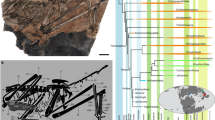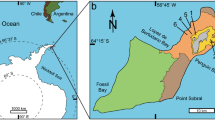Abstract
New specimens and an analysis of the Jehol pterosaur faunae of northeastern China show an unexpected diversity of flying reptile groups in terrestrial Cretaceous ecosystems1,2,3,4. Here we report two new pterosaurs that are referred to European groups previously unknown in deposits of northeastern China. Feilongus youngi, from the Yixian Formation1,3, is closely related to the Gallodactylidae5,6 and is distinguished by the presence of two independent sagittal crests and a protruding upper jaw. Nurhachius ignaciobritoi, from the Jiufotang Formation2,3, has teeth formed by labiolingually compressed triangular crowns, only previously reported in Istiodactylus latidens7 from England. With these new discoveries, the Jehol pterosaurs show a wide range of groups including both primitive and derived forms that are not matched by any other deposit in the world. The discoveries also document the turnover of pterosaur faunae, with the primitive Anurognathidae and early archaeopterodactyloids being replaced by derived pterodactyloids. Furthermore, these deposits offer an opportunity to examine the interaction and competition between birds and pterosaurs—it indicates that the avian fauna during the Lower Cretaceous (and possibly most of the Mesozoic) dominated terrestrial, inland regions, whereas pterosaurs were more abundant in coastal areas.
This is a preview of subscription content, access via your institution
Access options
Subscribe to this journal
Receive 51 print issues and online access
$199.00 per year
only $3.90 per issue
Buy this article
- Purchase on Springer Link
- Instant access to full article PDF
Prices may be subject to local taxes which are calculated during checkout




Similar content being viewed by others
References
Swisher, C. C. et al. A Cretaceous age for the feathered dinosaurs of Liaoning, China. Nature 400, 58–61 (1999)
He, H. Y. et al. Timing of the Jiufotang Formation (Jehol Group) in Liaoning, northeastern China, and its implications. Geophys. Res. Lett. 31, 1–4 (2004)
Chang, M., Chen, P. J., Wang, Y. Q. & Wang, Y. (eds) The Jehol Biota (Shanghai Sci. and Technol. Publishers, Shanghai, 2003)
Zhou, Z. H., Barrett, P. M. & Hilton, J. An exceptionally preserved Lower Cretaceous ecosystem. Nature 421, 807–814 (2003)
Wellnhofer, P. The Illustrated Encyclopedia of Pterosaurs (Salamander Books, London, 1991)
Kellner, A. W. A. in Evolution and Paleobiology of Pterosaurs (eds Buffetaut, E. & Mazin, J. M.) 105–137 (Geological Society, London, Special Publication 217, 2003)
Howse, S. C. B., Milner, A. R. & Martill, D. M. in Dinosaurs of the Isle of Wight (eds Martill, D. M. & Naish, D.) 324–335 (The Paleontological Association, London, 2001)
Kellner, A. W. A. Remarks on pterosaur taphonomy and paleoecology. Acta Geologica Leopoldensia 39, 175–189 (1994)
Kellner, A. W. A. & Langston, W. Jr Cranial remains of Quetzalcoatlus (Pterosauria, Azhdarchidae) from the Late Cretaceous Sediments of Big Bend National Park, Texas. J. Vertebr. Paleontol. 16, 222–231 (1996)
Ji, S. A., Ji, Q. & Padian, K. Biostratigraphy of new pterosaurs from China. Nature 398, 573–574 (1999)
Wang, X. L. et al. A nearly complete articulated rhamphorhynchoid pterosaur with exceptionally well-preserved wing membranes and “hairs” from Inner Mongolia, northeast China. Chinese Sci. Bull. 47, 226–230 (2002)
Wang, X. L. & Zhou, Z. H. Two new pterodactyloid pterosaurs from the Early Cretaceous Jiufotang Formation of western Liaoning, China. Vertebrata Palasiatica 41, 34–41 (2002)
Wang, X. L. & Zhou, Z. H. A new pterosaur (Pterodactyloidea, Tapejaridae) from the Early Cretaceous Jiufotang Formation of western Liaoning, China and its implication for biostratigraphy. Chinese Sci. Bull. 48, 16–23 (2003)
Kellner, A. W. A. & Tomida, Y. Description of a new species of Anhangueridae (Pterodactyloidea) with comments on the pterosaur fauna from the Santana Formation (Aptian-Albian), Northeastern Brazil. Natl Sci. Mus. Monogr. 17, 1–135 (2000)
Bennett, S. C. The osteology and functional morphology of the Late Cretaceous pterosaur Pteranodon. Palaeontographica Abt. A 260, 1–112 (2001)
Unwin, D. M. in Evolution and Paleobiology of Pterosaurs (eds Buffetaut, E. & Mazin, J. M.) 139–190 (Geological Society, London, Special Publication 217, 2003)
Campos, D. A. & Kellner, A. W. A. Short note on the first occurrence of Tapejaridae in the Crato Member (Aptian), Santana Formation, Araripe Basin, Northeast Brazil. An. Acad. Bras. 69, 83–87 (1997)
Bennett, S. C. Soft tissue preservation of the cranial crest of the pterosaur Germanodactylus from Solnhofen. J. Vertebr. Paleontol. 21, 43–48 (2002)
Unwin, D., Lü, J. & Bakhurina, N. N. On the systematic and stratigraphic significance of pterosaurs from the Lower Cretaceous Yixian Formation (Jehol Group) of Liaoning, China. Mitt. Mus. Nat.kd. Berl. Geowiss. Reihe 3, 181–206 (2000)
Czerkas, S. A. & Ji, Q. in Feathered Dinosaurs and the Origin of Flight (ed. Czerkas, S. J.) 15–41 (The Dinosaur Museum, Utah, 2002)
Wang, X. L. & Lü, J. C. The discovery of a pterodactyloid pterosaur from Yixian Formation of western Liaoning, China. Chinese Sci. Bull. 46, 1112–1117 (2001)
Lü, J. C. A new pterosaur: Beipiaopterus chenianus, gen. et sp. nov. (Reptilia: Pterosauria) from western Liaoning Province of China. Mem. Fukui Pref. Dino. Mus. 2, 153–160 (2003)
Li, J. J., Lü, J. C. & Zhang, B. K. A new Lower Cretaceous sinopterid pterosaur from the western Liaoning, China. Acta Palaeontol. Sin. 42, 442–446 (2003)
Kellner, A. W. A. & Campos, D. A. The function of the cranial crest and jaws of a unique pterosaur from the Early Cretaceous of Brazil. Science 297, 389–392 (2002)
Wellnhofer, P. & Buffetaut, E. Pterosaur remains from the Cretaceous of Morocco. Paläontologische Zeitschrift 73, 133–142 (1999)
Dong, Z. M., Sun, Y. W. & Wu, S. Y. On a new pterosaur from the Lower Cretaceous of Chaoyang Basin, Western Liaoning, China. Global Geol. 22, 1–7 (2003)
Wu, X. C., Sues, H. D. & Brinkman, D. B. An atoposaurid neosuchian (Archosauria: Crocodyliformes) from the Lower Cretaceous of Inner Mongolia (People's Republic of China). Can. J. Earth Sci. 33, 599–605 (1996)
Kielan-Jaworowska, Z., Cifelli, R. L. & Luo, Z. X. (eds) Mammals from the Age of Dinosaurs—Origins, Evolution, and Structure (Columbia Univ. Press, New York, 2004)
Viohl, G. in The Beginnings of Birds (eds Hecht, M. K., Ostrom, J. H., Viohl, G. & Wellnhofer, P.) 31–44 (Freunde des Jura-Museums, Eichstaedt, 1985)
Ponte, F. C. & Ponte Filho, F. C. in Boletim 4 Simpósio Sobre Cretáceo do Brasil (eds Brito, D. D., Rohn, R. & Perinoto, J. A.) 123–133 (UNESP, Rio Claro, 1996)
Acknowledgements
We thank M. Chang for supporting this work; J. Huang, M. Yang and V. Machado for the drawings and help with preparation of the illustrations; W. Gao for the photos; and Y. Li and L. Xiang for the preparation of the specimens. This study was funded by the National Natural Science Foundation of China, the National 973 Project, Chinese Academy of Sciences, Brazilian Academy of Sciences, Fundação Carlos de Chagas Filho de Amparo a Pesquisa do Rio de Janeiro (FAPERJ) and Conselho Nacional de Desenvolvimento Científico e Tecnológico (CNPq). A.W.A.K. and D.dA.C. are members of the Brazilian Academy of Sciences.
Author information
Authors and Affiliations
Corresponding authors
Ethics declarations
Competing interests
Reprints and permissions information is available at npg.nature.com/reprintsandpermissions. The authors declare no competing financial interests.
Supplementary information
Supplementary Methods
A phylogenetic analysis of the new pterosaur species. To access the phylogenetic position of the new pterosaur species described, we performed a phylogenetic analysis using PAUP 4.0b10 for Microsoft Windows (31). (DOC 101 kb)
Rights and permissions
About this article
Cite this article
Wang, X., Kellner, A., Zhou, Z. et al. Pterosaur diversity and faunal turnover in Cretaceous terrestrial ecosystems in China. Nature 437, 875–879 (2005). https://doi.org/10.1038/nature03982
Received:
Accepted:
Issue Date:
DOI: https://doi.org/10.1038/nature03982
This article is cited by
-
Study on the Jehol Biota: Recent advances and future prospects
Science China Earth Sciences (2020)
-
First complete pterosaur from the Afro-Arabian continent: insight into pterodactyloid diversity
Scientific Reports (2019)
-
The first flea with fully distended abdomen from the Early Cretaceous of China
BMC Evolutionary Biology (2014)
-
An Early Cretaceous pterosaur with an unusual mandibular crest from China and a potential novel feeding strategy
Scientific Reports (2014)
-
Competition and constraint drove Cope's rule in the evolution of giant flying reptiles
Nature Communications (2014)
Comments
By submitting a comment you agree to abide by our Terms and Community Guidelines. If you find something abusive or that does not comply with our terms or guidelines please flag it as inappropriate.



